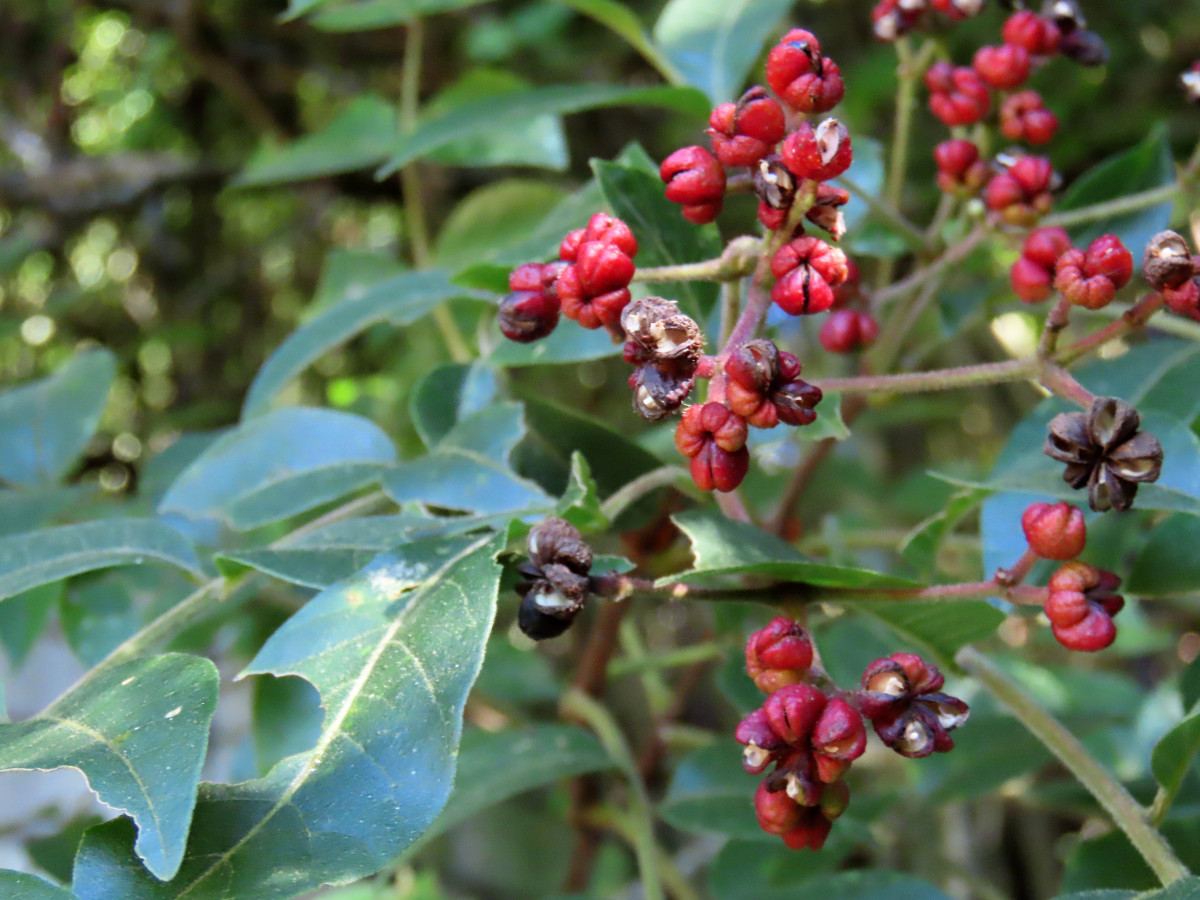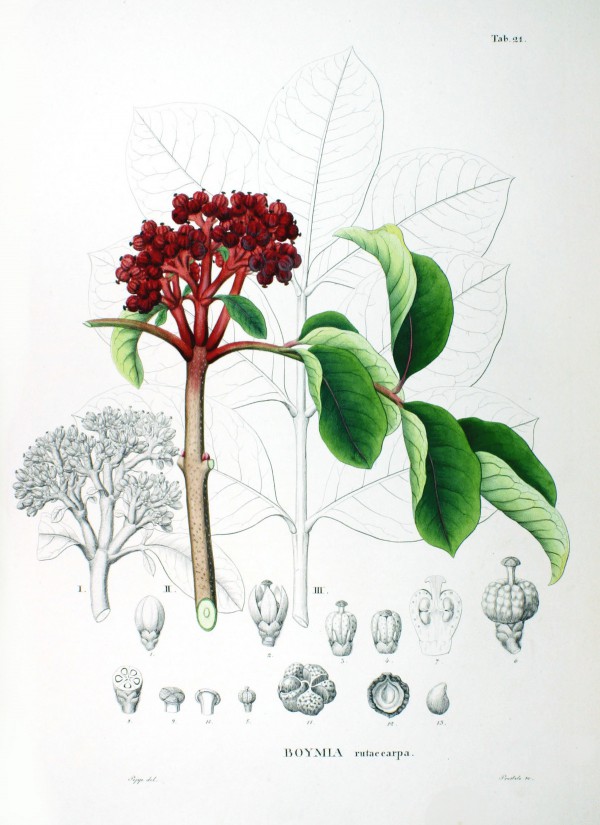Tetradium ruticarpum (A. Juss.) T. G. Hartley - syn.Euodia officinalis Dode; Euodia ruticarpa (A. Juss.) Benth.; Evodia rutaecarpa (Juss.) Benth.; Boymia rutaecarpa A. Juss. - Rutaceae - 吴茱萸 wu zhu yu (chin.), Evodia
Shrub or tree, to 9m tall, native to China and Korea.
http://www.efloras.org/florataxon.aspx?flora_id=2&taxon_id=242351597
„The fruit is usually used. It has a strong bitter taste, and is used in traditional Chinese medicine (TCM). Both the former genus name and the species name are often misspelled, and the plant usually appears in sources dealing with traditional Chinese medicine as „Evodia rutaecarpa“.“
http://en.wikipedia.org/wiki/Tetradium_ruticarpum
Limonin, the bitter principle from the dried fruits of Evodia rutaecarpa, showed inhibitory effects on bradykinin-induced paw edema and arachidonic acid-induced ear swelling. „Limonin inhibited the rise of vascular permeability induced by acetic acid and the increase of paw edema induced by carrageenin.“
[Antinociceptive and anti-inflammatory activities of limonin isolated from the fruits of Evodia rutaecarpa var. bodinieri., Matsuda, H., Yoshikawa, M., Iinuma, M., Kubo, M., Planta medica, Vol.64(4), 1998, 339-342]
„Wuzhuyu has been used in TCM for the treatment of inflammation-related disorders such as gastrointestinal problems, headache, menstrual complaints and externally against mouth ulcers… The n-hexane extract of the fruits of Evodia rutaecarpa showed a considerable inhibiting effect on leukotriene biosynthesis in human granulocytes. Bioassay-guided fractionation of the extract led to the isolation of the 5 quinolone alkaloids: 1-methyl-2-nonyl-4(1H)-quinolinone, 1-methyl-2-(6Z)-6-undecenyl-4(1H)-quinolinone, 1-methyl-2-(4Z,7Z)-4,7-tridecadienyl-4(1H)-quinolinone, evocarpine and 1-methyl-2-(6Z,9Z)-6,9-pentadecadienyl-4(1H)-quinolinone. The compounds exhibited inhibitory activity on leukotriene biosynthesis in a bioassay using human
polymorphonuclear granulocytes, with IC50 values of 12.1, 10.0, 10.1, 14,6 and 12.3 mM, respectively.“
[Inhibition of leukotriene biosynthesis by quinolone alkaloids from the fruits of Evodia rutaecarpa., Adams, M., Kunert, O., Haslinger, E., Bauer, R., Planta medica, Vol.70, 2004, 904-908]
Main volatile components of the dried fruits of E.rutaecarpa (HS-SPME) were limonene (33.7%), β-elemene (10.7%), linalool (8.1%), myrcene (5.8%), valencene (4.7%), β-caryophyllene (4.6%), linalyl acetate (4.1%) and α-terpineol (3.9%). The major volatiles of E. rutaecarpa (Juss.) Benth. var. officinalis (Dode) Huang (i.e. E. officinalis) fruits were myrcene (32.7%), limonene (18.3%), β-caryophyllene (9.9%), trans-β-ocimene (6.0%), linalool (5.8%), β-elemene (7.8%) and valencene (4.6%).
[Pellati, Federica, et al. „Headspace solid-phase microextraction-gas chromatography–mass spectrometry analysis of the volatile compounds of Evodia species fruits.“ Journal of chromatography A 1087.1 (2005): 265-273]
„Wu-Zhu-Yu, is an extract prepared from the small berry fruit of Evodia rutaecarpa and is reported to have anti-inflammatory and anti-nociceptic activity… In order to control the potency of the test article, we prepared a defined biomimetic mixture of synthetic and natural forms of the active components of Evodia fruit extract, containing rutaecarpine, dehydroevodiamine, and evodin… This Evodia biomimetic mixture was a potent inhibitor of UVB-induced PGE2 released by keratinocytes in culture. We found that MN also induces release of nitric oxide from cultured keratinocytes and microvascular endothelial cells. Twice daily application of 0.1–1% Evodia biomimetic mixture for 2 weeks significantly inhibited erythema after a MN challenge. A single application of 1% Evodia biomimetic mixture also significantly inhibited MN-induced erythema when applied at 60 min before, or within 5 min after MN exposure. The Evodia biomimetic mixture was significantly more effective at inhibiting erythema than bisabolol, the active component of chamomile. Conclusions: These results demonstrate that compounds found in E. rutaecarpa (including the indole quinazoline alkaloids) have powerful anti-inflammatory activity when applied topically to human skin.“
[Anti-inflammatory activity in skin by biomimetic of Evodia rutaecarpa extract from traditional Chinese medicine., Yarosh, D.B., Galvin, J.W., Nay, S.L., Peña, A.V., Canning, M.T., Brown, D.A., Journal of dermatological science, Vol.42(1), 2006, 13-21]
„The dried unripe fruit of E. rutaecarpa is a commonly used Chinese medicinal herb and has been recommended for the treatment of abdominal pain, acid regurgitation, nausea, diarrhea, hernia and dysmenorrhea and is also used externally for treatment of aphthous stomatitis. The herb is also documented as insecticidal/anti-parasitic in the literature… The essential oil of E. rutaecarpa showed strong fumigant toxicity against the adults of the red flour beetles and maize weevils. Moreover, the essential oils also possessed fumigant toxicity against other stored products, rice weevil (S.oryzae) and bean weevil (Callosobruchus chinensis) as well as cigarette beetle (Lasioderma serricorne)… Hydrodistillation of dried unripe fruits of E. rutaecarpa yielded 2.45% essential oil (v/w)… The main constituents of the essential oil were β-myrcene (17.7%), (Z)-β-ocimene (14.8%), α-phellandrene (14.7%), γ-terpinene (6.4%), linalool (5.7%) and β -thujene (5.1%)… The results of chemical composition of the essential oil were quite different from the previous reports. For example, trans-β-ocimene (66.1%) was the major compound followed by cis-β-ocimene (8.6%) and β-myrcene (6.2%) in the essential oil of E. rutaecarpa unripe fruits harvested from sichuan province (Southwest China) 19 . However, β-myrcene (39.3%) and β-phellandrene (12.9%) were two main components of the essential oil of E. rutaecarpa fruits collected from hunan province (Central China). β-Caryophyllene oxide (14.7%), Z-11-pentadencenal (13.6%) and globulol (7.2%) were the main constitutes of the essential oil of E. rutaecarpa leaves harvested from shanxi province (Northwest China)… Considering the currently used fumigants are synthetic insecticides, fumigant activity of the crude essential oil and the three isolated compounds are quite promising and they show potential to be developed as possible natural fumigants for control of stored product insects with low toxicity to humans.“
[Fumigant components from the essential oil of Evodia rutaecarpa Hort unripe fruits., Liu, Z.L., Du, S.S., Journal of Chemistry, 8(4), 2011, p.1937-1943] http://downloads.hindawi.com/journals/chem/2011/256729.pdf
The hydrodistilled essential oil of Evodia rutaecarpa unripe fruits was found to possess insecticidal activity against maize weevils. Main components were β-myrcene (17.7%), (Z)-β-ocimene (14.8%), α-phellandrene (14.7%), γ-terpinene (6.4%), linalool (5.7%) and β-thujene (5.1%).
[Liu, Zhi Long, and Shu Shan Du. „Fumigant components from the essential oil of Evodia rutaecarpa Hort unripe fruits.“ Journal of Chemistry 8.4 (2011): 1937-1943] http://downloads.hindawi.com/journals/chem/2011/256729.pdf
„Essential oils from the fruit of two species of Evodia rutaecarpa from China (Evodia rutaecarpa (Juss.) Benth. var. officinalis (Dode) Huang and Evodia rutaecarpa (Juss.) Benth.) have been obtained by hydrodistillation and analysed by gas chromatography-mass spectrometry in order to discern the differences and similarities between the volatile chemical compositions of these species. More than 21 components were identified in essential oils of the studied plants. In the oil of E. rutaecarpa (Juss.) Benth. var. officinalis (Dode) Huang, the main essential oil ingredients were β-myrcene (44.43%) and β-pinene (39.88%). β-pinene (72.82%), 1R-α-pinene (8.90%) and β-myrcene (1.99%) were the major compounds in the oil of E. rutaecarpa (Juss.) Benth. The chemical compounds of the essential oils showed that there are only six common compounds between the two species.“
[Cai, Guang-Xian, et al. „Comparative analysis of essential oil components of Evodia rutaecarpa (Juss.) Benth. var. officinalis (Dode) Huang and Evodia rutaecarpa (Juss.) Benth.“ Natural product research 26.19 (2012): 1796-1798]
The essential oil of the fruits, obtained by steam distillation, is used as fragrance material for its green fruity aromatic topnote, reminescent of hot chilies and piemento with natural papaya and mango aspects.
[Firmenich datasheet Evodia EO 941806, Feb 2015] Firmenich retr. 20251017

Tetradium ruticarpum, Hsinchu, Taiwan (2025) © 大俠 CC BY-SA 4.0 inaturalist.org

Euodia ruticarpa (A. Juss.) Benth. [as Boymia rutaecarpa A. Juss.]
Siebold, P.F. von, Zuccarini, J.G., Flora Japonica, t. 21 (1875)
http://plantgenera.org/species.php?id_species=416734
